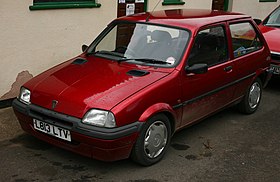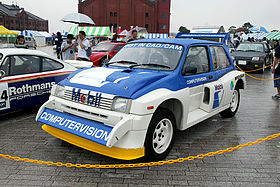MG Metro 6R4
| Austin Metro | |
|---|---|
 |
|
| Overview | |
| Manufacturer |
British Leyland (1980–1986) Rover Group (1986–1998) |
| Also called | Austin Mini Metro Morris Metro MG Metro Rover Metro Rover 100 Van Den Plas Metro |
| Production | 1980–1998 |
| Body and chassis | |
| Class | Supermini (B) |
| Layout | Front-engine, front-wheel drive |
| Related | Mini |
| Chronology | |
| Successor | None, Indirect: Rover 200 MkIII/Rover 25 MG ZR Mini Hatch |
| Austin Metro | |
|---|---|

1989 Austin Metro 1.3 GS 5-door
|
|
| Overview | |
| Manufacturer |
British Leyland: BL Cars Ltd (1980-83) Austin Rover Group(1983-88) Rover Group Rover Cars (1986-90) |
| Also called | Austin Mini Metro Rover Metro MG Metro Morris Metro |
| Production | 1980–1990 |
| Assembly | Longbridge, Birmingham, England |
| Designer |
David Bache Harris Mann |
| Body and chassis | |
| Body style | 3-/5-door hatchback 3-door van |
| Platform | LC8 |
| Powertrain | |
| Engine | 1.0 L A-Series I4 1.3 L A-Series I4 1.3 L A-Series turbo I4 |
| Transmission | 4-speed BMC Manual transmission (ADO88/LC8) 4-speed BMC-AP automatic (ADO88/LC8) |
| Dimensions | |
| Wheelbase | 2,250 mm (88.6 in) |
| Length | 3,400 mm (133.9 in) |
| Width | 1,550 mm (61.0 in) |
| Height | 1,360 mm (53.5 in) |
| Kerb weight | 760 kg to 865 kg |
| Rover Metro | |
|---|---|
 |
|
| Overview | |
| Manufacturer | Rover (Rover Group) |
| Also called | Rover 100 (Europe) |
| Production | 1990–1994 |
| Body and chassis | |
| Class | Supermini (B) |
| Body style | 3-door hatchback 5-door hatchback 2-door convertible 3-door panel van |
| Powertrain | |
| Engine | 1.1 L K-series SPI 8V I4 1.4 SPI K-series 8/16V 1.4 MPI K-series 8/16V 1.4 L PSA/TUD3 diesel I4 |
| Transmission | 4/5-speed PSA manual |
| Dimensions | |
| Wheelbase | 88.6 in (2,250 mm) |
| Length | 134.1 in (3,406 mm) |
| Width | 61.6 in (1,565 mm) |
| Height | 53.5 in (1,359 mm) |
| Kerb weight | 1,852lbs (840 kg) |
| Chronology | |
| Predecessor | Mk2 Metro |
| Rover 100 | |
|---|---|
 |
|
| Overview | |
| Manufacturer | Rover |
| Production | 1994–1998 |
| Body and chassis | |
| Class | Supermini (B) |
| Body style | 3-/5-door hatchback 2-door convertible |
| Platform | R6 |
| Powertrain | |
| Engine | 1.1 L K-series SPI 8V I4 1.4 SPI K-series 8/16V 1.4 MPI K-series 8/16V 1.5 L PSA/TUD5 diesel I4 |
| Transmission | 5-speed PSA manual Van Doorne VT-1 CVT automatic |
| Chronology | |
| Predecessor | Rover Metro |
| MG Metro 6R4 | |
|---|---|
 |
|
| Overview | |
| Manufacturer | Austin Rover Group, Austin Rover World Rally Team |
| Production | 1984–87 |
| Body and chassis | |
| Body style | 3-door hatchback |
| Platform | Rear mid-engine, four-wheel drive |
| Related | MG Metro |
| Powertrain | |
| Engine | 2991 cc V6 DOHC bore and stroke of 92×75 mm power output of 250 bhp (186 kW) or 410 bhp (306 kW) dependent upon spec |
| Transmission | 5-speed manual |
The Metro is a supermini car that was produced by British Leyland (BL) and, later, the Rover Group from 1980 to 1998. It was launched in 1980 as the Austin miniMetro. It was intended to complement and eventually replace the Mini, and was developed under the codename LC8. The Metro was named by What Car? as Car of The Year in 1983 as an MG, and again as a Rover in 1991.
During its 18-year lifespan, the Metro wore many names: Austin Metro, MG Metro and Rover Metro. It was re-badged as the Rover 100 series in January 1995. There were also van versions known as the Morris Metro and later, Metrovan.
At the time of its launch, the Metro was sold under the Austin brand. From 1982, MG versions became available. During 1987, the car lost the Austin name, and was sold simply as the Metro. From 1990 until its withdrawal in 1998, the Metro was sold only as a Rover.
Although the R3 generation Rover 200 (introduced in 1995 and smaller than previous 200 models) had originally been designed as a replacement for the Metro, it was not marketed as such after its launch. The Rover 100 finally ceased production in 1998, being out-lived (by three years) by the original Mini that it was meant to replace. 2,078,218 Metros of all types were built.
On 8 October 1980, BL introduced the Austin mini Metro. The roots of the Metro lay in an earlier project denoted as ADO88 (Amalgamated Drawing Office, 88-inch wheelbase), which was intended to be a direct replacement for the Mini. However, poor reception to the ADO88 design at customer clinics, coupled to the realisation within BL that Mini-sized cars were evolving into larger "superminis", such as the Ford Fiesta, Fiat 127, Renault 5 and Volkswagen Polo, forced a major reappraisal of the project after 1975. In late 1977, ADO88 was given an eleventh hour redesign, to make it both larger and less utilitarian in appearance, whilst the Mini itself would now remain in production in smaller numbers alongside it as a budget entry-level model. The revised project was given the new designator LC8 (Leyland Cars No8), and the definitive Metro design would ultimately emerge under the leadership of BL's chief stylists David Bache and Harris Mann.
...
Wikipedia
